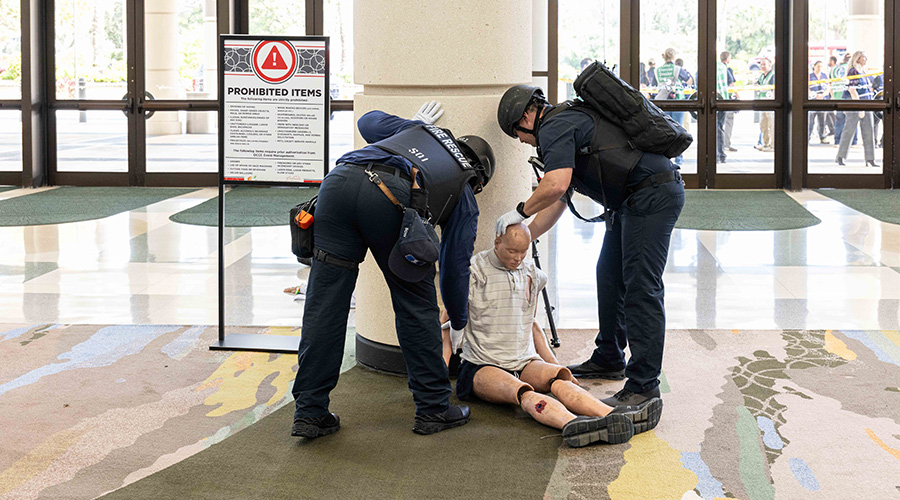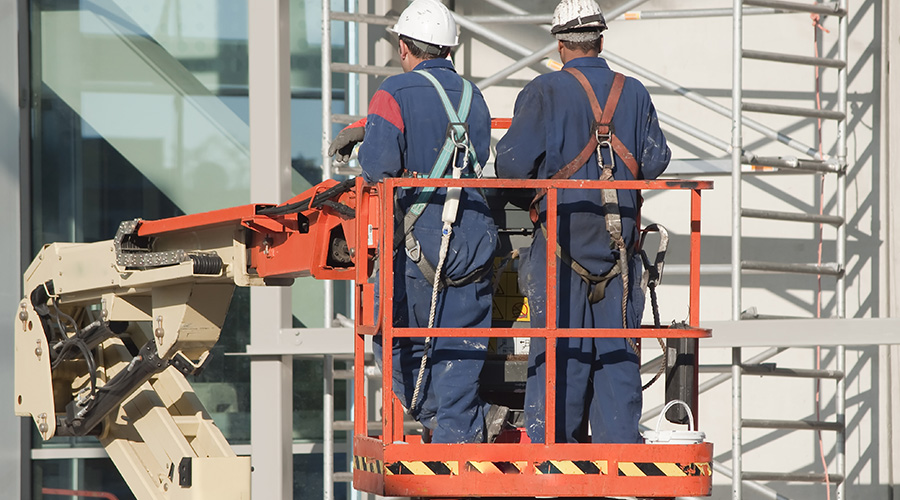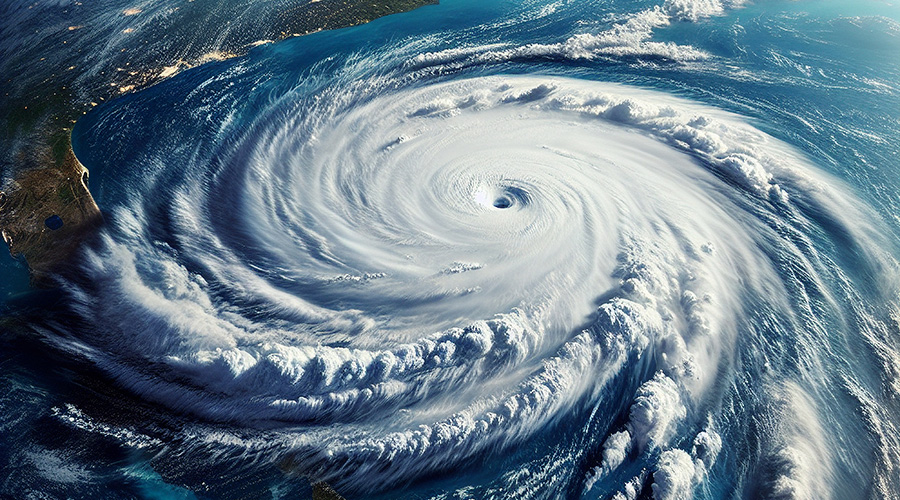Hard Times in the Big Easy
Hurricane Katrina puts disaster
response plans to an unprecedented test
other coverage...
Hertz Group: Coming to Grips With Devastation
BellSouth: Restoring Communication
Gale: Lessons in Emergency Preparedness
Wells Fargo: Banking on Preparations
Marriott: No Time to Rest
As Hurricane Katrina churned wildly toward the Gulf Coast, Jim Berry, director of engineering for JW Marriott Orlando Grande Lakes, marshaled the resources he knew he would need to bring the hotel chain’s 19 New Orleans-area properties back to life after the tempest had come and gone.
Berry is an expert at mopping up after hurricanes. After weathering four brutal hurricanes in 2004, and numerous others in years past, he was designated as point man for Marriott International’s massive recovery efforts, says Lenny Jachimowicz, vice president of engineering for Marriott International.
In the days preceding the storm, a task force began to converge on Louisiana. With the Baton Rouge Courtyard hotel as a staging ground, Berry collected equipment and specialists who would be prepared to roll once the storm passed. As part of the preparation, everybody on the recovery team was vaccinated against diseases, such as hepatitis B and tetanus.
“We knew the storm was coming,” Jachimowicz says. “Jim assembled a team in Baton Rouge, a team of engineers that would to go in once the buildings were safe and secure. We hired restoration contractors, and we had all of these people staged and ready to go as soon as we were allowed back in.”
Rounding up additional generators was another priority.“We knew we’d probably not see power for a month,” Jachimowicz says.
Getting Ready
Meanwhile, 80 miles away in New Orleans, crisis plans were set in motion. Each hotel began to implement shelter-in-place procedures, securing a three-day supply of food and water for the more than 1,700 guests and associates unable to escape the storm.
Each property was equipped with a portable generator that kept essential systems online during the storm. Prior to the storms, all the generators had been tested at full load and all of their tanks had been topped off.
“We went through a lot of pre-planning,” Jachimowicz says. “One of the things we learned after 9/11 and the blackouts in the Northeast was how to shelter in place. We were significantly more prepared than we might have been. We had enough food and water to take care of people for 72 hours. Each hotel performed as designed.”
Armed security protected each property from the surrounding chaos. Once the roads were safe,
“We got everyone out of the city,” Jachimowicz says. “Then we went back. We deployed our team as soon as we were allowed to go in.”
Security teams moved ahead of recovery teams, clearing out those who had sought refuge in the hotels after guests and employees left.
The recovery crew moved first into Metairie, a suburban community located on the southern shore of Lake Pontchartrain in Jefferson Parish, and set up shop in the parking lot of the Residence Inn. Soon called “Camp Metairie,” it was the first property recovered and became the new staging ground.
“We got to Metairie, cleaned it up, then moved the task force from Baton Rouge to Metairie. We used the parking lot to stage our move into the city of New Orleans,” Jachimowicz says.
Even without watching the news, Jachimowicz says they assumed they were on their own.
“We didn’t rely on any government agency,” he says. “We counted on our contractors and own personnel. Our position was that we were going to go in and do the best we could given the conditions, and not put folks in harm’s way. And we pulled it off. Our people showed tremendous resolve. They were sleeping on cots and in sleeping bags, and eating out of temporary kitchens. We were feeding hundreds of people a day. And we kept moving the operation forward.”
The team worked methodically to clean up and secure the various building systems, focusing first on the HVAC and electrical systems.
“We boarded up windows, secured the air conditioning and electrical systems, and did a lot of things proactively right after we got there to keep the buildings from getting worse,” Jachimowicz says.
Bringing water systems back online proved to be the biggest challenge — and taught a new lesson in disaster recovery. Potable water was hard to find. City water and sewer systems failed.
“I think we may have underestimated the value of pressurized water in a building,” Jachimowicz says. “We were prepared to lose electricity, but throughout all the other storms we’ve been through, I’ve never seen a city’s water and sewer system fail. I think it shows the value of water as it relates to overall operations and how complex it is to get temporary water with a temporary generator.”
The company ended up hiring tanker trucks to haul water from Houston.
The recovery task force also had to deal with the aftermath of flooding. One property suffered significant flooding, with 3 feet of water in the lobby. And drying it out was only half the battle. After the property was dried out, an industrial hygienist came in to make sure it was safe to inhabit.
As the floodwaters receded, black mold flourished throughout the region. The industrial hygienist spent several weeks making sure all of the facilities were free of black mold or any of the other health hazards that began cropping up in the area, Jachimowicz says.
Within a week, the first property was ready to receive guests — or in this case, additional crews to help with the cleanup process.
Checking In
By late September, many of the properties were opened on a limited basis, becoming home to FEMA officials, relief workers, insurance representatives and others sent to help the city recover.
As the properties were cleaned up, hotel management staff returned to finish the job and prepare the hotels for routine operations. Jachimowicz credits the relatively smooth recovery to intense training, planning and coordination — and having one experienced person in charge on the ground to issue specific instructions every day. But beyond the task force, the entire recovery effort was an example of corporate teamwork.
By mid-October, life began returning to normal. The Marriott had opened 12 hotels in the New Orleans area and began accepting reservations from the general public for November stays.
“The group did a phenomenal job,” Jachimowicz says. “We had daily conference calls. We were linked with human resources. We were linked with sales. All displaced associates were placed in other Marriotts with pay. This wasn’t just about the buildings. It was a massive, companywide undertaking.”
Hertz Group: Coming to Grips with Storm’s Devastation
By Mike Lobash, executive editor
Maurice Faucheux returned to New Orleans a week after Hurricane Katrina ripped through the city, taking with it parts of the roof and much of the glass that protected the buildings he oversees for the Hertz Investment Group.
Stunned by the devastation, the New Orleans native started taking photos of the central business district along Poydras Street, where his firm’s buildings stood with blown out windows and holes in the roofs. After snapping a few shots, however, he put his camera away.
“I stopped taking pictures because the photos were showing just one little scene,” Faucheux says. “I couldn’t capture the fact that 80 percent of the city was underwater.” Nor could he — or anyone at that point — comprehend the extent of damage to the New Orleans properties Hertz manages: four downtown office towers totaling 2.1 million square feet, a 500,000-square-foot urban mall and a 110,000-square-foot suburban office park.
Nonetheless, Faucheux, general manager for Hertz, determined the best course was to assess damage at the buildings, assemble a response team, maintain communications with city officials, set a schedule to reopen buildings and begin remediation.
Although volunteer engineers who stayed in the buildings during the hurricane were able to monitor some damage, assessing damage afterward was difficult without electricity. Faucheux and a senior project manager walked to the 26th, 27th and 28th floors of three buildings twice during the first week to assess roof damage. Several times daily, he would walk between 10 and 15 floors.
Scene of Devastation
The tower with the worst damage had more than 1,600 windows blown out, damaging tenant offices throughout the building, Faucheux says. Water entered through the broken windows and cascaded into the building through openings in the roof where vents had been torn off and large sections of the roof itself were ripped loose.
Inside the building, ceilings caved in, light fixtures and HVAC supply vents fell, drywall collapsed and some door frames were twisted. Every elevator and escalator pit in the building flooded, as did the parking garage.
Hertz contracted with a disaster recovery firm to aid in the initial remediation. Some of the initial work included cleaning up broken glass and other debris. The firm also created a so-called moisture map of each building to determine where drywall and carpet would have to be removed.
Recovering from the hurricane involved more than just repairing buildings, however. The Hertz group hired legal and professional services firms to interpret insurance documents, review casualty damage clauses in tenant leases and establish a Web site to communicate with tenants and employees.
In the weeks since the storm passed, Faucheux says, signs that downtown New Orleans is returning to normal have cropped up. Power has been restored. Municipal services have come online. Floodwaters have receded. Still, getting buildings up and running will take time.
Two of the Hertz Group’s buildings and the mall will be closed for months while they undergo repairs. The others opened at the end of October.
For Faucheux personally, seeing the devastation left in the storm’s wake has been difficult. Having lived through hurricanes Betsy in 1965 and Camille in 1969, he has seen the destruction such violent hurricanes cause. But Katrina was even more devastating. After evacuating New Orleans this year with his family to Florida, he expected the worst when he returned.
“I had mentally prepared to have nothing,” he says.
BellSouth: Restoring Communications
By Greg Zimmerman, managing editor
For four days after Katrina hit, the city of New Orleans fell into complete darkness after sunset. Reports of violence and looting filled news reports. But on the fourth night, city residents and news cameras saw something hopeful: a flag, illuminated by spotlights, flying at half mast on a downtown high rise. It was a symbol of hope and determination that NBC News compared to the unforgettable photo of firefighters raising the flag amid the rubble of the destroyed World Trade Center.
The New Orleans tower where the flag flew was a BellSouth building, and it was BellSouth facility managers who climbed to the roof, ran lines from an emergency generator to the spotlights, and raised the flag.
Raising the flag was not the only way BellSouth’s response lifted spirits, not only in the areas hit by Katrina, but across the nation. As guardians of the communications infrastructure across the devastated region, the company’s facility employees knew their role was critical: One of the stories behind the story of any disaster is the anxious hours spent by people who can’t reach family and friends because of downed power and phone lines and cell phone service outages.
Building Preparations
The company has more than 500 facilities — switching stations, work centers and administration space — in Louisiana and Mississippi alone, so preparedness is a Herculean task. Each building has its own emergency plan, all of which are reviewed yearly prior to hurricane season.
John Vinson, vice president of corporate real estate and services, says each team of first responders should include electrical and mechanical experts, as well as facility managers.
Vinson positioned vendors so that once access to the city was allowed, cleanup could begin immediately. The process included working with local officials so that BellSouth vendors and employees were some of the first permitted in. Officials deemed it critical that downed network stations were restored.
Thanks to that planning, the outages in many areas were much shorter than expected or were prevented altogether. About 23 facilities across Louisiana and Mississippi were knocked completely out of service by the storm and the subsequent flooding. As of press time, about 10 are still out.
The impact of the hurricane would have been even more devastating if it hadn’t been for what Vinson calls the heroic efforts of BellSouth employees across the region. In Gulfport, Miss., for example, Katrina knocked a gaping hole in the wall of a room that houses a critical emergency generator for a switching facility. Using spare plywood and other materials facility staff found in the basement, the team stationed in the facility temporarily rebuilt the wall and kept the switch up and running.
Hard Lessons
The flooding and Katrina’s destruction taught Vinson and his team important lessons in how to prepare and recover immediately after a large-scale disaster. First among those was diversifying the recovery workforce — both of BellSouth employees and contracted vendors.
“We have to make sure we’re not dependent on our local employees so that they can take care of personal issues,” says Vinson. “We have to make sure that they’re given time off to handle family issues.”
Vinson also says that having a good understanding of insurance and what costs are covered is critical. So is making sure that risk management guidelines are clearly stated.
The flooding created environmental health and safety issues — such as contaminated water. Vinson says he learned a lesson about having to get up to speed quickly on dealing with flooded space tainted with petroleum — something he never imagined would be the case.
As the recovery effort continues, Vinson and his team are working with local officials to prioritize the reconstruction of the remaining downed switching facilities. In the most heavily damaged building, where there was 10 to 12 feet of flood water, Vinson says he doesn’t expect the facility to be back up for another six to eight months.
“There are some things we don’t have control over,” he says. “But all switches will come back up.”
Gale: Lessons in Emergency Preparedness
By Greg Zimmerman, managing editor
Ian Marlow may not be a Boy Scout, but “be prepared” is still the motto he lives by. As Hurricane Katrina approached New Orleans, Marlow, president of Gale Global Facility Services, a division of The Gale Corporation, led the efforts to prepare the company’s stock of class A office buildings on the outskirts of the city.The Gale Corporation is a commercial real estate investment firm with more than 60 million square feet of space in 32 countries.
Preparations for the storm required a multifaceted approach. Marlow says the most important parts were people-focused — forming disaster recovery teams, distributing duties and making sure staff members knew their responsibilities before, during and after the storm.
“If the guy that is supposed to be flipping on the generator goes home, we have a problem,” he says. “Preparation starts and ends with the people.”
Another piece of the company’s storm preparation puzzle is its customized Web portal. The portal allows Marlow and his staff to communicate in real time with clients, landlords and tenants at all its buildings in at-risk areas. When Katrina loomed, a new “instance” was set up on the portal specific to Katrina, so anyone logging into the system would know exactly where to enter and view relevant data. Because the company sets aside an area of the portal specific to each disaster, employees can go back and research what measures were taken before, during and after storms so that lessons can be learned and methods improved.
During the storm itself and the recovery phase, the portal allows the teams removed from the storm to be the “eyes in the sky” for the team members actually weathering the storm and planning recovery. For instance, says Marlow, if someone at a facility needed fuel, that person wouldn’t have to drop everything to go look for it. Managers at Gale’s headquarters could check with nearby company-managed facilities, and have fuel sent out from one with a sufficient supply. “We only want people to leave when they absolutely have to,” he says.
The portal also allows the company to easily set up alternate locations if a facility is knocked out completely. Although none of Gale’s properties sustained serious damage, the company’s meticulous preparations offer lessons in planning for potential disasters.
Before the Storm Hits
Some of the steps Marlow recommends for emergency preparedness include:
- Review all evacuation plans for each building in the area. Make sure tenants are aware of the evacuation plans and know what to do.
- Carefully track the storm’s progress so that, within reasonable limits, the time, strength and location can be projected. Having people in constant communication with the National Weather Service is critical.
- Have all vendors, including janitorial, security and landscaping, on call and ready so that cleanup and repairs can be made immediately following the storm.
- Work closely with local authorities to know who needs to be evacuated, when evacuation needs to happen, and when employees will be allowed back in.
- Make sure that home contact information for all associates in the area is up-to-date, so that post-storm follow-up can be conducted, even if the building is still out of service. Also make sure that emergency numbers are easily available and posted somewhere in each facility and that employees have emergency numbers stored on their wireless devices. Make sure the landlord’s information is current.
- Make sure the emergency kit at each facility is fully stocked with water, medical supplies and duct tape.
- If there is food service in the building, contact food service vendors to make arrangements to keep refrigerators and food storage areas unlocked. Facility managers stationed at the facilities to ride out the storm will be very appreciative.
- Close all doors inside each building so that flying glass will be contained.
- Remove all potential flying objects from outside the facility, including picnic tables, basketball hoops, etc.
- Top off all fuel tanks and generators.
- Make sure cell phones and all other batteries are charged. Make sure there is a supply of backup batteries for flashlights and other devices.
Wells Fargo: Banking on Preparations
By Lynn Proctor Windle, contributing editor
Just as New Orleans and other parts of the Gulf Coast were beginning to recover from Katrina, Hurricane Rita hit the Texas Gulf Coast.
Anxious residents had watched as the predicted path of the storm moved from Houston and Galveston, and then to the Southeast Texas and Southwest Louisiana border.
Initial forecasts predicted that Hurricane Rita could be even more devastating than Hurricane Katrina.
It was Mike Wileman’s turn to swing into action. The maintenance manager and environmental coordinator for Wells Fargo corporate properties group spent the days before Hurricane Rita rumbled ashore swinging a hammer. He and 12 other employees were dispatched from the company’s regional office in Fort Worth to implement the financial company’s hurricane preparedness plan — a plan they had trained on just a few months before.
The company had anticipated a rough hurricane season. “We had our emergency preparedness in hurricane training in March,” Wileman says. The plan encompassed everyone in the organization, from property managers to retail personnel. During the training, the company developed call trees so it could keep tabs on its personnel and its facilities, a plan that proved to be invaluable.
Once on the ground, Wileman and his crew worked through a punch list, boarding or taping up windows, sealing doors and checking drains. Methodically, each team started at the back of the building and worked its way forward, allowing the facility to conduct business until the last minute.
Once the last customers and employees had left, Wileman sealed up the main doors and tossed sandbags in front of the door to keep water from seeping in.
The crew started in Houston and moved east as the hurricane’s predicted landfall shifted east. In three days, they boarded up 34 buildings, using more than 600 pieces of plywood.
Keeping Tabs on People
Once the buildings were secured, Wileman and his crew moved at least 50 miles inland to ride out the storm. Crews were stationed in different towns with the thought that somebody somewhere would be able to get to whatever emergency might arise.
After the storm, the call tree “is what really made it easier for us,” he says. “If we had people living in an area, we could ask them to drive over and check the facility and communicate what they saw. A lot of times, we couldn’t get into an area, so dispatch would tell us who to talk to. Everyone worked together.”
As well-prepared as Wileman and his team were, the impact of the hurricane came as a shock. “The damage was unbelievable,” Wileman says. “It wasn’t just the hurricane, but the effects of the flooding. All throughout Port Arthur, anything made of metal is gone, ripped apart. Trees were gone.”
Most of Wells Fargo’s properties required only cleanup, patching, painting and drying out. However, the fate of one building was still undecided by the end of September. A Class A commercial building made of glass, it suffered the full force of the winds.
“There was no way to board it,” Wileman says. Its two-story atrium blew apart and exterior glass shattered. It will have to undergo a structural evaluation before any decision is made about what will be done with the building.
“We’re hoping to build it back,” Wileman says.
The minute the hurricane passed, the Wells Fargo team began to truck in work crews, generators, food, water and other necessities. With no place to stay in the area, personnel and supplies were shuttled in daily. As workers left town for the night, they donated their unused food and water to a local VFW that served as an impromptu shelter.
Local Support
Wells Fargo’s recovery plan includes the use of local contractors when possible.
“A lot of businesses were hurt by the storm,” he says. “We really felt strongly about using the people in the community. We have good relationships with our vendors, and they would call to let us know they were back in. Cleanup crews and landscapers all asked to be used.
Wells Fargo doesn’t expect a final damage estimate until all the facilities are brought back online. But Wells Fargo walked away with some lessons of its own in disaster preparedness.
“There are some things we never thought about, like taking sun screen,” Wileman says. “The sun was really intense right before the storm hit. Hanging plywood in the bright sun, we all got sunburned.”
Cash, gas and extra water are going to be added to the list of provisions to bring back when going into a disaster zone.
“With electricity down, motels and such would only accept cash,” he says. “These are things you never think of. Learn as you go.”
By early October, Wells Fargo had reopened all but two of its branches.
Related Topics:











